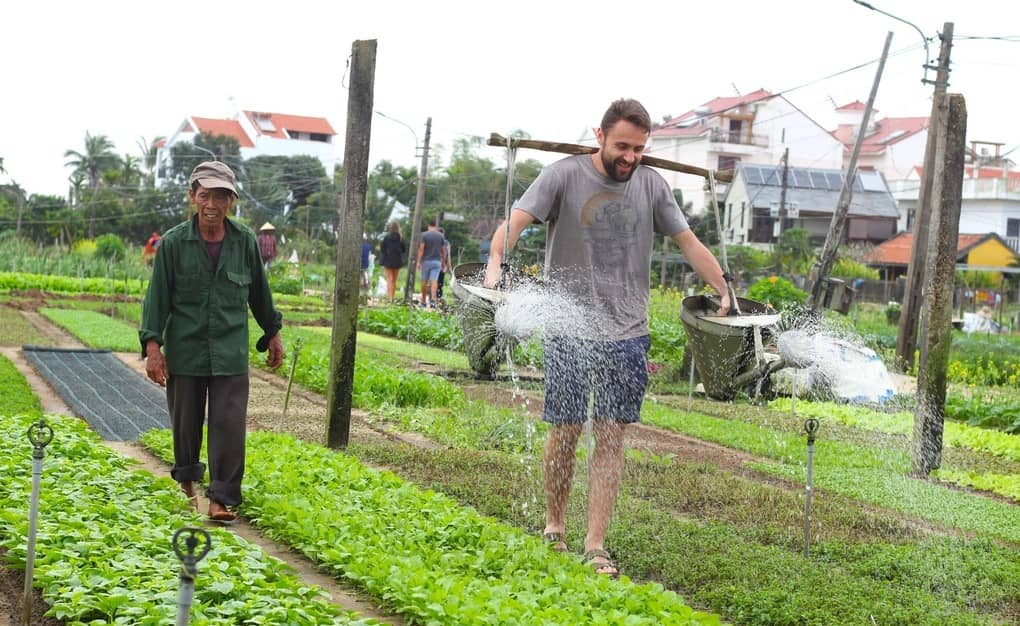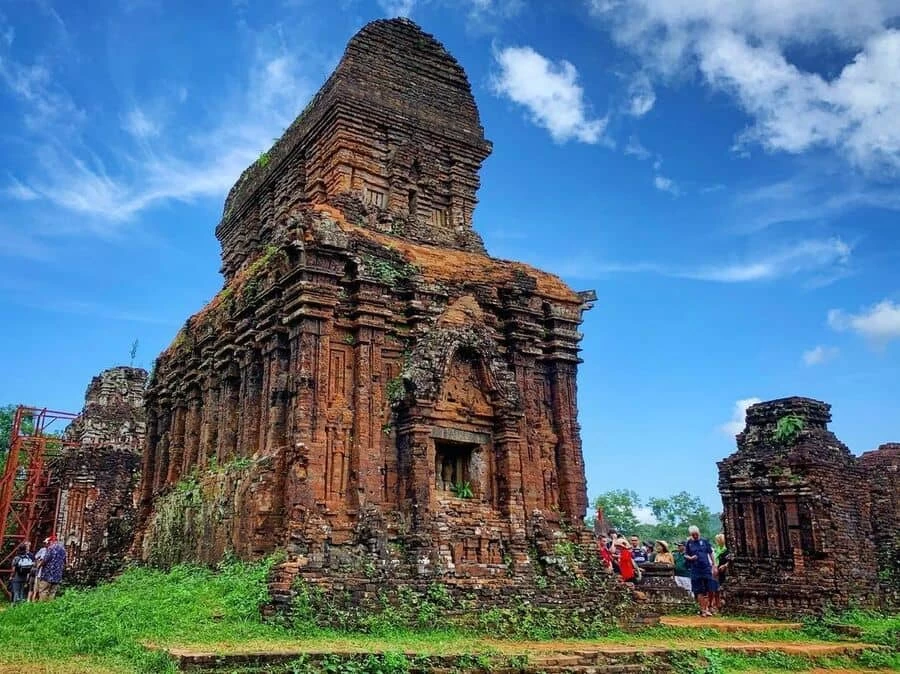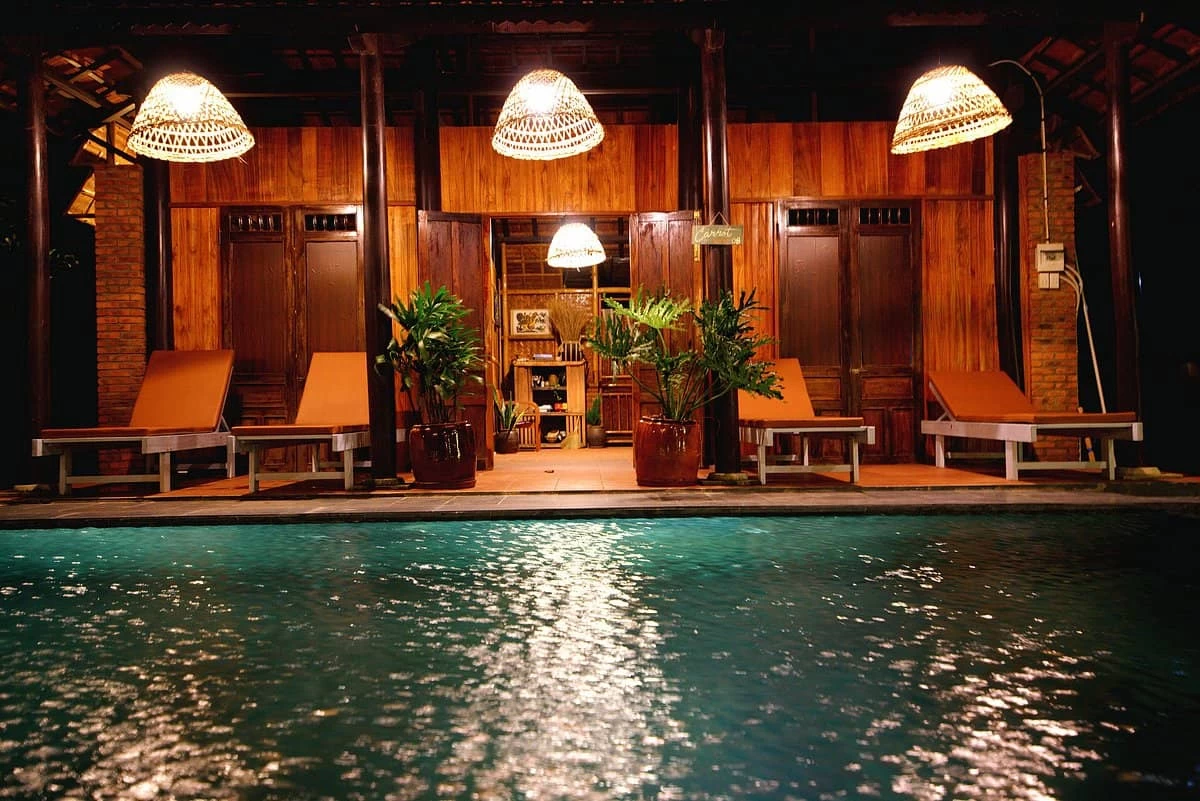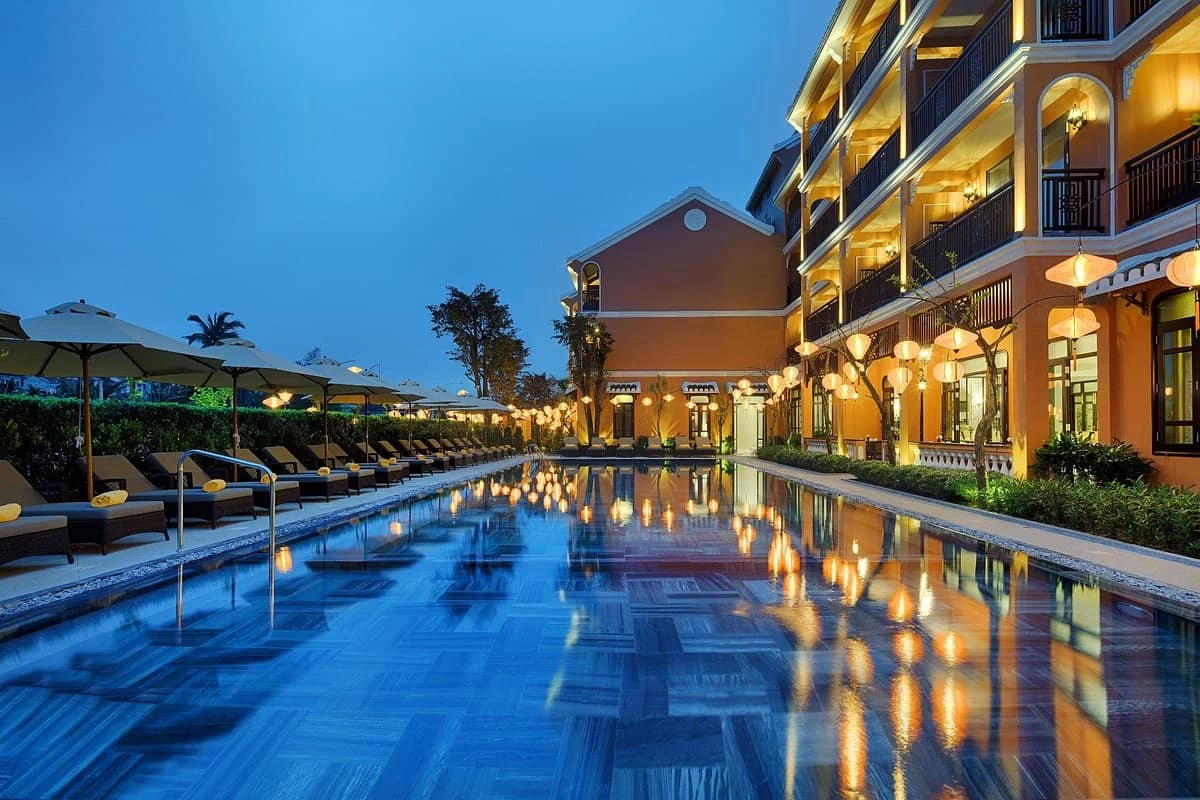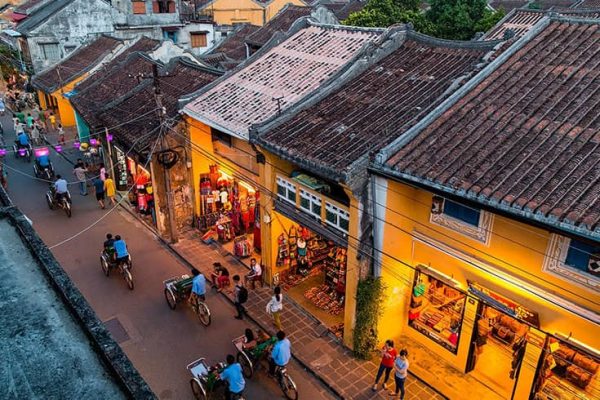
Hoi An gives visitors true taste of local culture
Explore the captivating Hoi An culture, delving into its architectural legacy, time-honored festivals, delectable cuisine, and sustainable tourism ventures. Immerse yourself in the cultural richness of Hoi An, a UNESCO World Heritage Site, as you uncover its historic edifices, engage in traditional celebrations, savor authentic culinary delights, and participate in eco-conscious travel activities. Experience the vibrant essence of Hoi An’s cultural heritage firsthand! Follow Ula Travel now!
I. Introduction to Hoi An
1. Where is Hoi An?

Hoi An used to be a busy trading port in the past
Hoi An, a charming ancient town located on the central coast of Vietnam, lies approximately 30 kilometers south of Da Nang. Situated along the Thu Bon River, Hoi An was historically a major Southeast Asian trading port from the 15th to the 19th centuries.
Its strategic position facilitated interactions with merchants from China, Japan, India, and Europe, making it a melting pot of diverse cultural influences. The town’s well-preserved architecture, a blend of indigenous and foreign styles, serves as a testament to its rich historical past.
2. UNESCO World Heritage Recognition
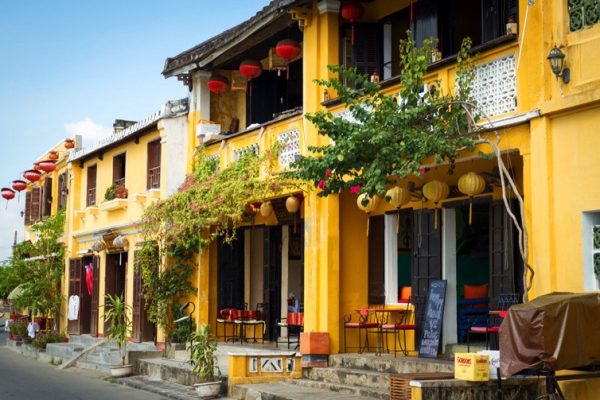
Hoi An is one of UNESCO World Heritage Sites in Vietnam
In 1999, Hoi An was recognized as a UNESCO World Heritage Site. This prestigious designation was awarded in acknowledgment of its exceptionally well-preserved ancient town, which showcases a unique fusion of cultures over several centuries.
UNESCO highlighted the town’s extensive array of historic buildings, streets, and overall urban planning, which reflects indigenous and foreign influences harmoniously integrated over time. This recognition has played a significant role in preserving Hoi An’s cultural heritage and promoting its global significance.
II. Why is Hoi An Culture Influenced by China, Japan, and Europe?
Hoi An’s cultural heritage bears the indelible marks of historical interactions with China, Japan, and Europe. Understanding the profound influence of these cultures provides insight into the rich tapestry of traditions found in Hoi An today.
1. Chinese Influence
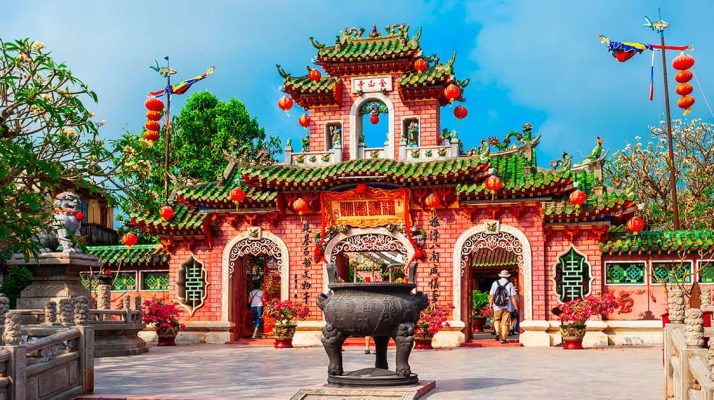
Phuc Kien Assembly Hall clearly shows Chinese culture
- Historical Trade Routes: Hoi An’s strategic location along the maritime Silk Road facilitated extensive trade between China and Southeast Asia, leading to a significant influx of Chinese merchants and settlers.
- Architecture and Design: The architectural landscape reflects strong Chinese influences, evident in the distinctive architectural styles of assembly halls, temples, and private residences. Intricate wooden carvings, ceramic decorations, and tiled roofs showcase the fusion of Chinese architectural elements with local craftsmanship.
- Cultural Practices: Chinese immigrants brought with them their customs, traditions, and religious beliefs, which became intertwined with the local culture. Festivals such as the Mid-Autumn Festival and Lunar New Year celebrations continue to be observed in this town, underscoring the enduring legacy of Chinese cultural influence.
Click here: Hoi An Tours
2. Japanese Influence
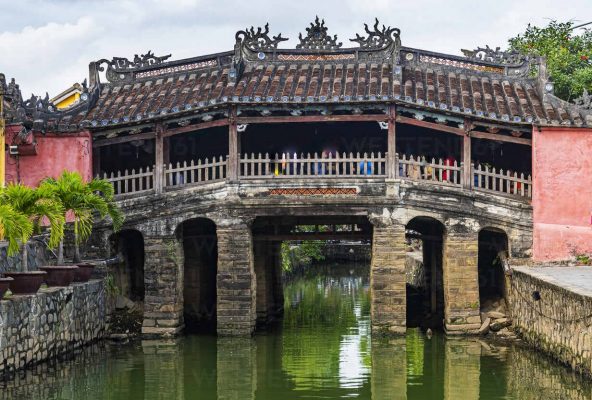
Japanese culture is expressed through the Japanese Covered Bridge.
- Traders and Merchants: During the 16th and 17th centuries, Hoi An served as a thriving trading port frequented by Japanese merchants. This period of economic exchange fostered cultural cross-pollination between Japan and Vietnam.
- Architectural Legacy: The iconic Japanese Covered Bridge stands as a tangible testament to the enduring influence of Japanese architecture. Built by Japanese traders in the 16th century, the bridge symbolizes the strong cultural ties between the two nations.
- Artistic Traditions: Japanese artisans introduced traditional crafts such as lacquerware and silk weaving to Hoi An, enriching the local artistic landscape. Today, remnants of Japanese craftsmanship can be found in the intricate designs adorning historic buildings and cultural artifacts.
Do not miss: Best things to do in Hoi An
3. European Influence
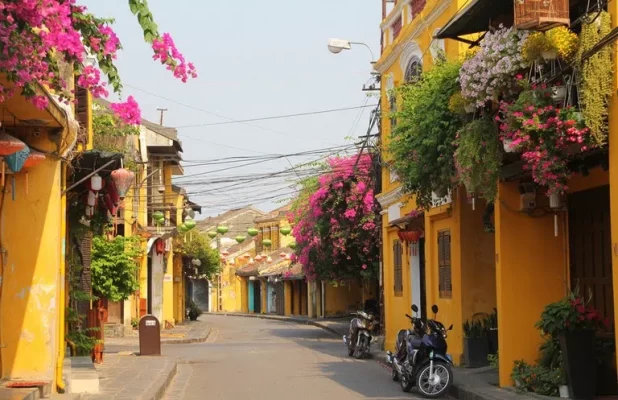
Most of house architecture has a European feel
- Colonial Era: The arrival of European colonial powers, particularly the Portuguese, Dutch, and French, left an indelible mark on Hoi An’s cultural identity. The establishment of trading posts and colonial settlements brought new ideas, technologies, and cultural practices to the region.
- Architectural Synthesis: European colonial architecture, characterized by ornate facades, arched doorways, and tiled roofs, coexists harmoniously with traditional Vietnamese structures in Hoi An Ancient Town. This architectural fusion reflects the dynamic interplay between Eastern and Western design aesthetics.
- Culinary Fusion: European traders introduced ingredients such as tomatoes, chili peppers, and potatoes to Vietnamese cuisine, leading to the development of fusion dishes that blend Eastern and Western flavors. The culinary landscape of Hoi An showcases this vibrant gastronomic exchange.
III. Architecture and Art
1. Prominent Architectural Landmarks
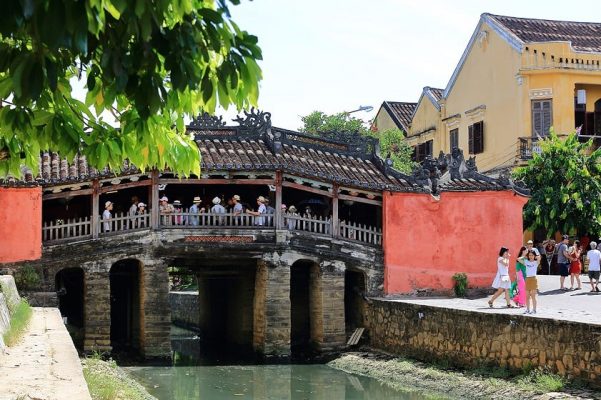
Japanese Covered Bridge
- Japanese Covered Bridge: This iconic bridge, dating back to the 18th century. It features a unique blend of Japanese and Vietnamese architectural styles, with a pagoda on one side and a shrine on the other.
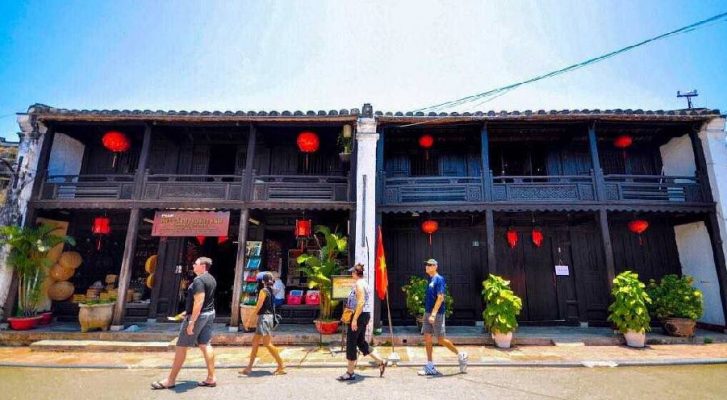
Phung Hung Ancient House
- Ancient Houses: Hoi An is renowned for its well-preserved ancient houses, reflecting a mix of Chinese, Japanese, and Vietnamese architectural influences. Notable examples include the Tan Ky Ancient House, the Phung Hung Ancient House, and the Quan Thang Ancient House.
Start your journey with: Explore Hoi An in 1 Day
2. Blend of Asian and European Architecture
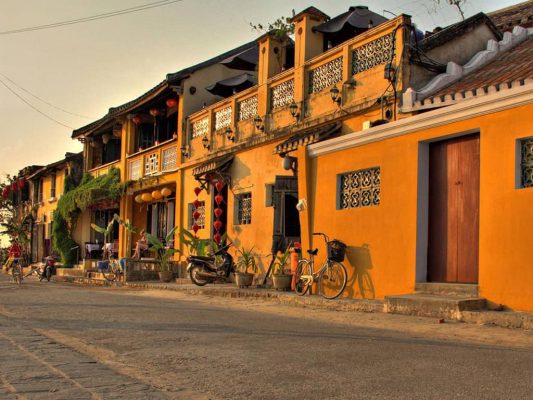
Ancient architecture is preserved intact in Hoi An
- Hoi An’s architecture is a testament to its rich history as a major trading port. Throughout its streets, one can observe a harmonious fusion of Asian and European architectural elements, showcasing the city’s cultural diversity and cosmopolitan heritage.
- The Old Town area is particularly noteworthy for its well-preserved colonial buildings, adorned with vibrant colors and intricate motifs reminiscent of French, Dutch, and Portuguese architectural styles.
Are you looking for: Central Vietnam Wonders Tour
3. Traditional Arts and Crafts
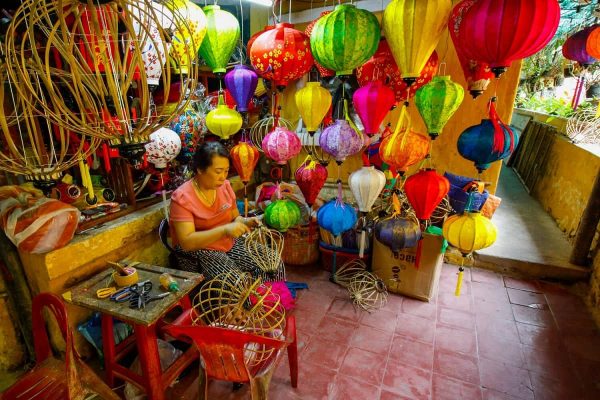
Traditional lantern making
- Lantern Making: Hoi An is famous for its enchanting lanterns, which illuminate the city’s streets and alleys, especially during festivals like the Lantern Festival. Visitors can participate in lantern-making workshops to learn about traditional techniques and create their own colorful lanterns.
- Pottery: The Thanh Ha village is renowned for its pottery craftsmanship, dating back centuries. Visitors can visit local workshops to witness artisans shaping clay into exquisite pottery items, ranging from vases and bowls to decorative figurines.
- Tailoring: Hoi An is hailed as the tailoring capital of Vietnam, where skilled tailors create bespoke garments with meticulous attention to detail. From traditional Ao Dai to modern suits, visitors can have custom-made clothing tailored to their preferences within a short turnaround time.
You might also like: Da Nang to Hoi An in 4 Days
IV. Festivals and Traditional Customs
Hoi An is renowned for its vibrant festivals and rich tapestry of traditional customs, offering visitors a glimpse into the local culture and heritage.
1. Major Festivals
Hoi An Lantern Festival
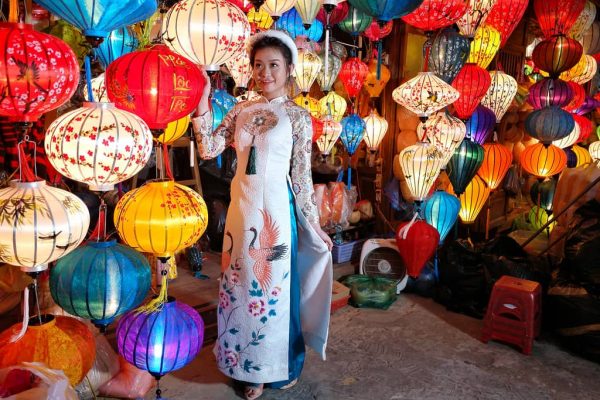
Hoi An Lantern Festival
- Description: The Hoi An Lantern Festival is a visually stunning celebration where the ancient town is illuminated with thousands of colorful lanterns. The streets are adorned with lanterns of various shapes and sizes, creating a mesmerizing spectacle.
- Timing: The Hoi An Lantern Festival typically takes place on the fifteenth day of the first lunar month, marking the first full moon of the lunar new year.
Lunar New Year
- Description: Lunar New Year is the most significant festival in Vietnam, celebrated with great fervor and enthusiasm. The streets come alive with traditional performances, dragon dances, and elaborate decorations.
- Timing: Lunar New Year usually falls in late January or early February, following the lunar calendar.
Mid-Autumn Festival
- Description: The Mid-Autumn Festival is a cherished event for families to gather and celebrate the harvest season. Children parade through the streets with colorful lanterns, while traditional lion dances entertain the crowds.
- Timing: The Mid-Autumn Festival occurs on the fifteenth day of the eighth lunar month, typically in September or October.
Learn more about: Discover My Son Sanctuary from Hoi An and Street Food Tour
2. Local customs and rituals
- Wedding Ceremonies: Traditional wedding ceremonies are steeped in customs and rituals that reflect the cultural heritage of the region. Ceremonies often include intricate rituals symbolizing luck, prosperity, and marital bliss.
- Ancestor Worship: Ancestor worship is an integral part of Vietnamese culture, emphasizing filial piety and respect for elders. Families gather to pay homage to their ancestors through offerings of food, incense, and prayers, seeking blessings and guidance.
V. Hoi An Cuisine – A Gastronomic Delight
Hoi An, a culinary paradise nestled in the heart of Vietnam, boasts a rich tapestry of flavors that reflect its diverse cultural influences and centuries-old culinary traditions. Let’s delve into the vibrant world of Hoi An cuisine and explore what makes it truly special.
1. Distinctive Characteristics of Hoi An Cuisine
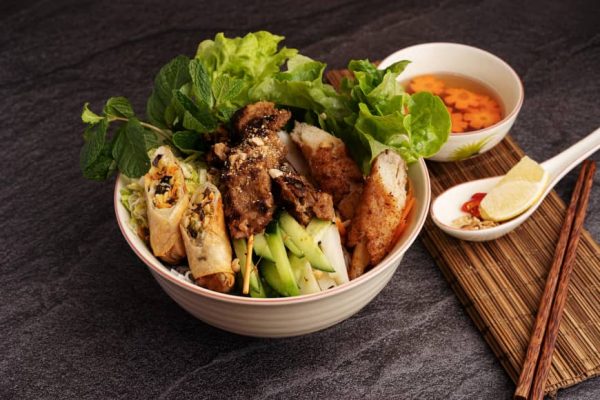
Hoi An cuisine is famous for its lightness and sophistication
Hoi An cuisine is renowned for its harmonious blend of Vietnamese, Chinese, and European culinary elements, resulting in a unique and delightful gastronomic experience. Here are some key characteristics that set Hoi An’s cuisine apart:
- Fresh Ingredients: Locally sourced, fresh ingredients play a pivotal role in Hoi An’s culinary creations, ensuring dishes burst with flavor and vibrancy.
- Subtle yet Complex Flavors: Dishes are characterized by their subtle yet complex flavors, achieved through meticulous seasoning and the skillful combination of herbs and spices.
- Focus on Lightness and Freshness: Unlike the heavier, richer cuisines found in other regions of Vietnam, Hoi An cuisine tends to emphasize lightness and freshness, making it a refreshing choice for discerning palates.
Read more: Hoi An street food
2. Culinary Heritage as a Reflection of Culture
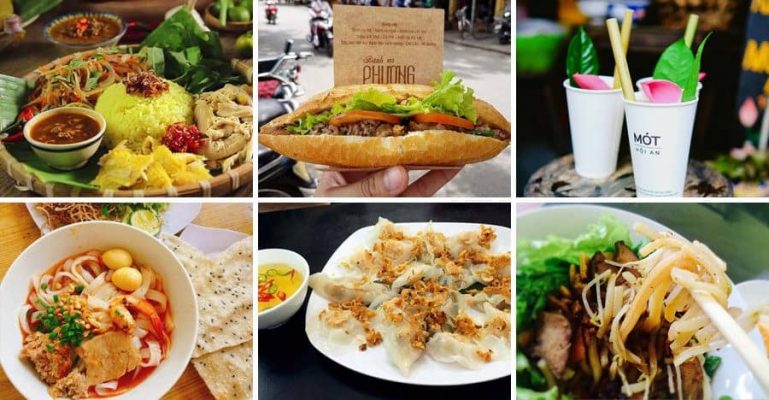
The history and culture of Hoi An are reflected in each dish.
The culinary heritage of Hoi An serves as a window into its rich cultural tapestry, showcasing:
- Historical Influences: Traces of trade influences from the 15th to 19th centuries are evident in dishes like Mi Quang (Quang-style noodles) with Chinese-style noodles and Japanese-style broth.
- Cultural Fusion: Fusion of Vietnamese, Chinese, Japanese, and European cooking techniques and ingredients, symbolizing the town’s role as a cultural melting pot.
- Celebrations and Rituals: Culinary traditions are intertwined with celebrations and rituals, such as Lunar New Year and traditional weddings, where special dishes hold symbolic significance.
- Community and Hospitality: The communal aspect of dining, with family-style meals and street food stalls fostering a sense of community and hospitality.
More details: Discover Central Vietnam Tour in 6 Days
3. Exploring Hoi An’s Culinary
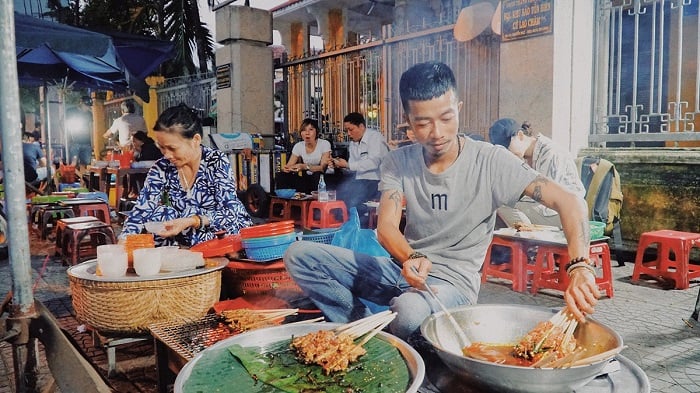
Roadside street vendors are an ideal choice to explore Hoi An cuisine.
Visitors can immerse themselves in Hoi An’s culinary scene through:
- Market Tours: Explore vibrant local markets like Hoi An Night Market to witness the array of fresh produce and seafood used in daily cooking.
- Cooking Classes: Participating in hands-on cooking classes led by local chefs to learn the secrets behind traditional Hoi An dishes.
- Street Food Adventures: Embarking on street food tours to sample an array of authentic snacks and dishes, from Banh Mi (a Vietnamese sandwich) to Banh Xeo (sizzling pancakes),.
- Fine Dining Experiences: Indulging in refined dining experiences at upscale restaurants offering modern interpretations of Hoi An classics.
VI. Cultural Tourism Activities
1. Guided Tours of Museums and Ancient Houses
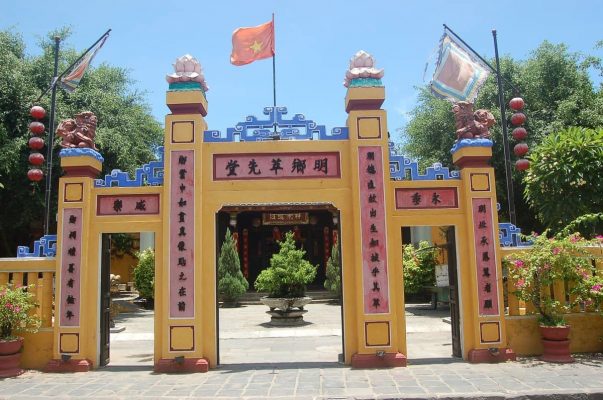
Hoi An Museum of History and Culture
- Hoi An boasts a rich cultural heritage, reflected in its numerous museums and ancient houses. Guided tours offer visitors the opportunity to delve into the history and culture of this enchanting town.
- Explore the Hoi An Museum of History and Culture, which showcases artifacts dating back centuries, provides insights into the town’s evolution.
- Visit iconic ancient houses like the Tan Ky Ancient House and the Phung Hung Ancient House, marveling at their unique architectural features and hearing captivating stories from knowledgeable guides.
2. Experience traditional craft villages
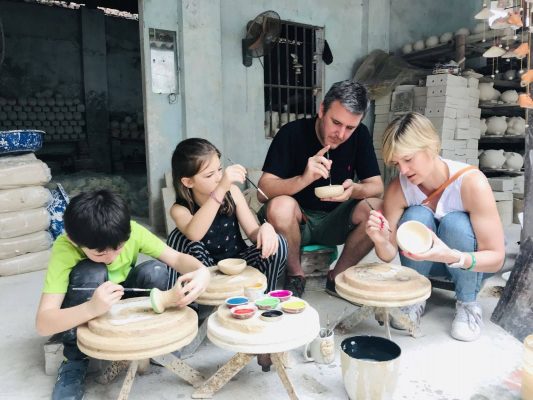
Thanh Ha Pottery Village
- Immerse yourself in the vibrant atmosphere of traditional craft villages, where time-honored techniques have been passed down through generations.
- Journey to Thanh Ha Pottery Village, where skilled artisans continue to produce exquisite ceramics using age-old methods. Visitors can witness pottery-making demonstrations and even try their hand at crafting their own masterpiece.
- Explore Tra Que Vegetable Village, a tranquil oasis renowned for its organic farming practices. Engage with local farmers, learn about traditional cultivation methods, and participate in hands-on activities such as planting and harvesting.
3. Workshops and Handicraft Classes
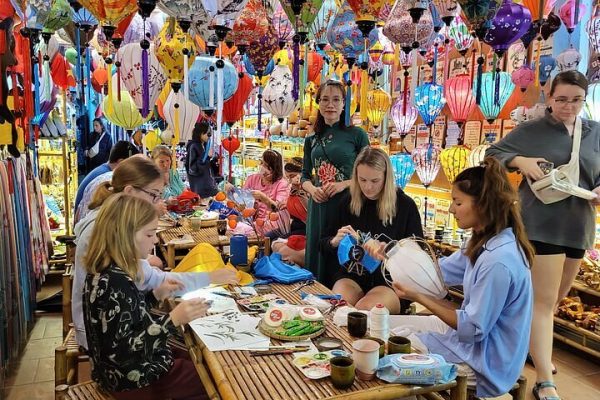
Lantern-making workshop
- Hoi An offers a plethora of workshops and handicraft classes catering to various interests and skill levels.
- Join a lantern-making workshop and discover the intricate artistry behind Hoi An’s iconic lanterns. Under the guidance of skilled artisans, participants can create their own colorful lanterns, perfect as souvenirs or decorative pieces.
- Enroll in a Vietnamese cooking class and learn the secrets of crafting authentic dishes bursting with flavor. From market visits to hands-on cooking sessions, these classes provide a comprehensive culinary experience that celebrates the diversity of Vietnamese cuisine.
- Engage in traditional textile workshops, where you can learn the art of silk weaving, embroidery, and fabric dyeing. Gain insights into traditional Vietnamese textiles and create your own bespoke textile masterpiece to cherish as a memento of your time in Hoi An.
4. Experiences with Traditional Art Performances in the Streets
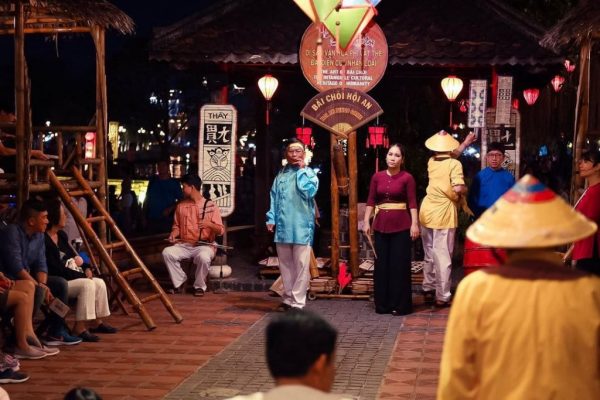
Bai Choi has been recognized by UNESCO as an Intangible Cultural Heritage
Hoi An, with its rich cultural heritage, offers a plethora of activities for tourists who wish to immerse themselves in the local culture. One of the most captivating experiences is witnessing traditional art performances that take place in the streets of this charming ancient town. These performances are not only entertaining but also provide a window into the rich traditions and history of the region.
VII. Best Ways to Experience Hoi An Culture
1. Participate in a Traditional Lantern-Making Workshop.
Delve into the artistry behind Hoi An’s iconic lanterns by joining a hands-on workshop led by local craftsmen. Learn about the intricate techniques of lantern making, from shaping the bamboo frames to embellishing them with colorful silk. Not only will you gain insight into this cherished craft, but you’ll also create a meaningful souvenir to commemorate your time in Hoi An.
2. Indulge in Authentic Hoi An Cuisine.
Embark on a culinary journey through Hoi An’s bustling markets and street food stalls, where the aroma of fragrant herbs and spices fills the air. Sample local specialties such as cao lau, a savory noodle dish unique to the region, and banh mi, a delicious Vietnamese sandwich infused with French influence. Engage with street vendors and market vendors to discover the stories behind each dish, fostering a deeper appreciation for Hoi An’s gastronomic heritage.
3. Attend a Traditional Performance or Cultural Show.
Immerse yourself in the vibrant traditions of Hoi An by attending a live performance showcasing the region’s folk music, dance, and storytelling. From graceful performances of traditional Vietnamese opera to lively displays of folk dances celebrating harvest festivals, these cultural shows offer a captivating glimpse into the heart and soul of Hoi An’s artistic heritage. Check local event listings or inquire at your accommodation for upcoming performances.
4. Cycle Through Hoi An’s Countryside and Villages.
Escape the hustle and bustle of the town center and embark on a leisurely bike ride through Hoi An’s picturesque countryside and rural villages. Traverse verdant rice paddies, meandering waterways, and quaint hamlets where time seems to stand still. Engage with friendly locals along the way, perhaps stopping for a refreshing glass of sugarcane juice or a glimpse into traditional farming practices. Cycling offers a serene and immersive way to connect with the authentic rhythms of rural life.
5. Join a Homestay Experience with a Local Family
For a truly authentic cultural immersion, consider staying with a local family through a homestay program. Immerse yourself in the daily rituals and customs of Vietnamese family life, from sharing home-cooked meals to participating in traditional activities such as rice planting or incense making. By forging genuine connections with your hosts, you’ll gain invaluable insights into the warmth and hospitality that define Hoi An’s community spirit.
In conclusion, Hoi An stands as a timeless gem, rich in cultural heritage and imbued with the echoes of its illustrious past. Through its labyrinthine streets, centuries-old architecture, and vibrant traditions, this enchanting town offers an immersive journey into the heart of Vietnamese culture.
We invite you to embark on your own odyssey through the streets of Hoi An. Whether you seek historical insights, culinary delights, or simply a moment of serenity amidst the bustle of modern life, Hoi An welcomes you with open arms, ready to unveil its timeless treasures and embrace you in its warm embrace. Don’t hesitate to text Ula Travel to get useful information and plan a great journey together!
See more: Hoi An Travel Tips



